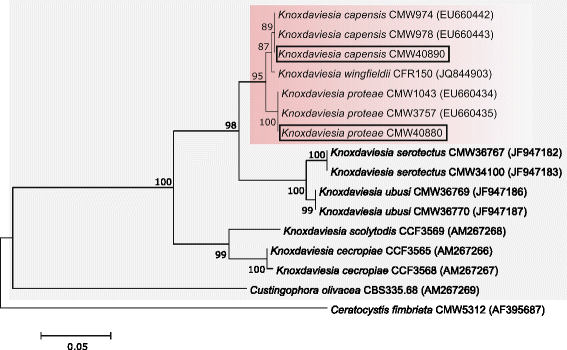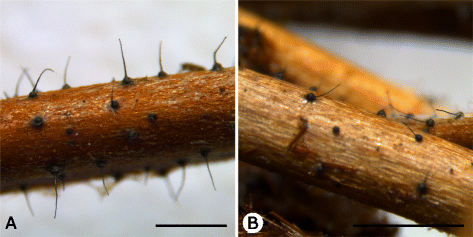Genome sequences of Knoxdaviesia capensis and K. proteae (Fungi: Ascomycota) from Protea trees in South Africa
- PMID: 26933475
- PMCID: PMC4772463
- DOI: 10.1186/s40793-016-0139-9
Genome sequences of Knoxdaviesia capensis and K. proteae (Fungi: Ascomycota) from Protea trees in South Africa
Abstract
Two closely related ophiostomatoid fungi, Knoxdaviesia capensis and K. proteae, inhabit the fruiting structures of certain Protea species indigenous to southern Africa. Although K. capensis occurs in several Protea hosts, K. proteae is confined to P. repens. In this study, the genomes of K. capensis CBS139037 and K. proteae CBS140089 are determined. The genome of K. capensis consists of 35,537,816 bp assembled into 29 scaffolds and 7940 predicted protein-coding genes of which 6192 (77.98 %) could be functionally classified. K. proteae has a similar genome size of 35,489,142 bp that is comprised of 133 scaffolds. A total of 8173 protein-coding genes were predicted for K. proteae and 6093 (74.55 %) of these have functional annotations. The GC-content of both genomes is 52.8 %.
Keywords: Gondwanamycetaceae; Knoxdaviesia; Microascales; Ophiostomatoid fungi; Protea.
Figures


References
-
- Spatafora JW, Blackwell M. The polyphyletic origins of ophiostomatoid fungi. Mycol Res. 1994;98:1–9. doi: 10.1016/S0953-7562(09)80327-4. - DOI
-
- Wingfield BD, Viljoen CD, Wingfield MJ. Phylogenetic relationships of ophiostomatoid fungi associated with Protea infructescences in South Africa. Mycol Res. 1999;103:1616–20. doi: 10.1017/S0953756299008990. - DOI
-
- Manning J, Goldblatt P. Plants of the Greater Cape Floristic Region. 1: The Core Cape Flora. Strelitzia 29, vol 29. Pretoria: South African National Biodiversity Institute; 2012.
-
- Gibbs RG. Analysis of the size and composition of the southern African flora. Bothalia. 1984;15:613–29.
-
- Rebelo T. Proteas: a field guide to the Proteas of Southern Africa. Vlaeberg: Fernwood Press; 1995.
Publication types
LinkOut - more resources
Full Text Sources
Other Literature Sources
Miscellaneous

